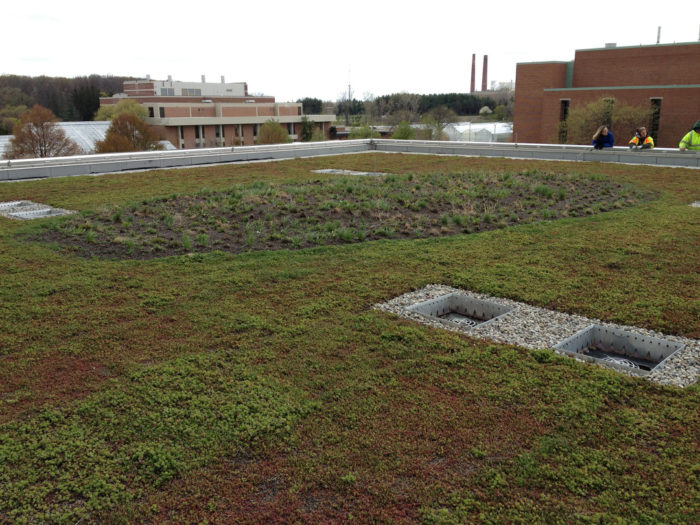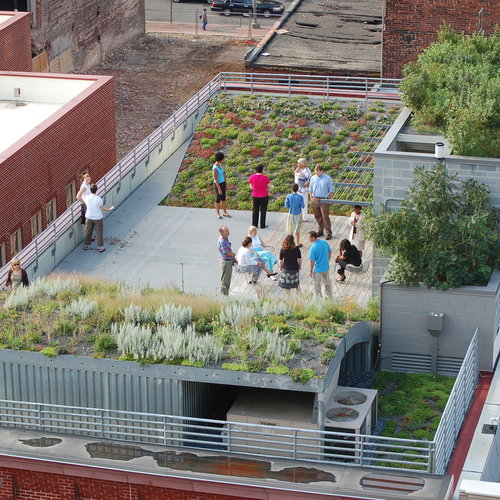
Image Credit: MSU Infrastructure via Flickr
A proposal facing Denver voters next month would require developers of buildings larger than 25,000 square feet to cover part of the roof with vegetation or solar panels.
In September, environmental activists narrowly won the right to place the Denver Green Roof Initiative before voters by collecting just 45 more petition signatures than they needed, The Denver Post reported.
The new rules would place Denver among a small number of North American cities requiring vegetation or solar panels to lessen the impact of heat-reflective roof surfaces. The Post said a 2014 analysis showed Denver’s average daily temperature during the summer over the previous decade was 4.9 degrees higher than in nearby rural areas. That put Denver behind only Las Vegas and Albuquerque on a list of U.S. cities most affected by the heat island effect.
Led by Madison Backens, a 22-year-old biology student at the University of Colorado Denver, activists began collecting signatures to place the initiative on the ballot earlier this year. The proposal establishes a sliding scale for roof coverage depending on the size of the building. It would require rooftop gardens to cover at least 20% of the roof area on new buildings between 25,000 and 50,000 square feet. At the high end, for buildings more than 200,000 square feet in size, 60% of the roof would have to be covered. Solar panels could be used to meet part of the requirement.
Existing buildings would be required to meet the same standard when their roofs were replaced. Multifamily residential buildings of four stories or less are not included, and city officials would have the power to allow smaller rooftop gardens in certain cases, the newspaper said.
Environmentalists excited, City Hall is not
Jennifer Bousselot of the Colorado Native Plant Society called the plan “bold and exciting” and said that environmentalists in the state have been pressing for this type of “policy breakthrough” for a decade.
Critics, however, are many, and the initiative isn’t getting much support from City Hall. The local ABC affiliate, Denver 7, quoted Mayor Michael Hancock as saying the proposal “is not the right approach for Denver.”
In a letter to some members of the Denver City Council earlier this month, Hancock wrote, “By taking a mandate-only approach and eliminating the opportunity for options, the initiative would actually hinder efforts to pilot, promote, phase and incentivize green infrastructure, as is being done in many of our peer cities across the United States. We would have much preferred to see a collaborative approach, which has become the hallmark of how we solve problems here in Denver.”
The president of the Colorado Apartment Association, Rocky Sundling, said the requirement would be costly and in some cases difficult for developers to carry out. He told The Post: “We certainly agree that there are some advantages to having green roofs. But mandating it seems counterintuitive. If it is a good solution, the market will make it happen.”
Proponents acknowledge the initiative would increase construction costs, but they argue roof membranes would last longer under vegetation, and energy use would decline, so operating costs over be lower over time.
In the runup to Election Day, opponents are far ahead in fund-raising with more than $41,000 in hand, compared to the $6,400 raised by those promoting the initiative.
Toronto claims the distinction of being the first city in North America to require green roofs on new construction. Its ordinance went into effect in 2010. San Francisco says it’s the first American city to require solar and vegetation on most new construction with the San Francisco Better Roofs rule that went into effect in January of this year.
Weekly Newsletter
Get building science and energy efficiency advice, plus special offers, in your inbox.















7 Comments
Vegetative roofs are particularly dumb
https://buildingscience.com/documents/insights/bsi-052-seeing-red-over-green-roofs
If these developers actually build roofs that must be watered, Denver will gain a lot of dead, heavy, and leaky roofs once the expensive maintenance starts being neglected.
Fortunately, after 5 minutes of research, these developers will opt for solar PV instead, which does make economic sense.
I just hope the appeal of lush roof gardens doesn't fog their thinking.
This particular type of mandate may or may not be the best approach. But in the last few years both Switzerland and Germany have put in programs that have resulted in a huge increase in green roofs. If this is resulting in "a lot of dead, heavy, and leaky roofs" then there should be some good studies to document that fact, if it is a fact.
How about less buildings and some native revegetation? We can't build our way out of climate change, we must work with the natural systems.
User ...121,
Given that the population of both the US and Canada is increasing, how will we decide who for without housing?
Be creative, double up, make due with the current housing stock. A lot of empty bedrooms in the US and Canada I would bet. As a builder, I lost interest in new housing long ago and concentrated on the refurbishment of existing, close in housing. Reduce, reuse, recycle.
Make do? Until we have to pay more for fossil fuels, who's going to voluntarily take in boarders? Seems like a carbon tax could make the cost of heating empty bedrooms more painful. Heck, forget the tax, how about just end subsidies for legacy fuels?
It's been 6 years since this narrowly passed. Anyone know how it has played out?
Log in or create an account to post a comment.
Sign up Log in